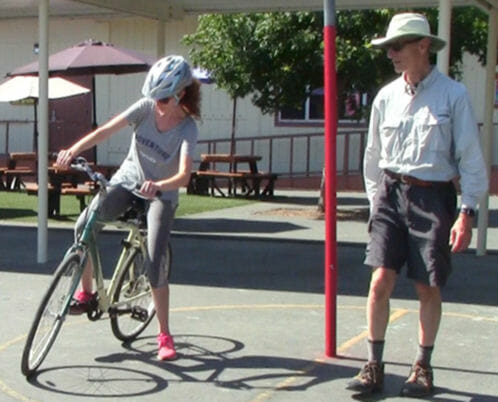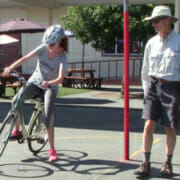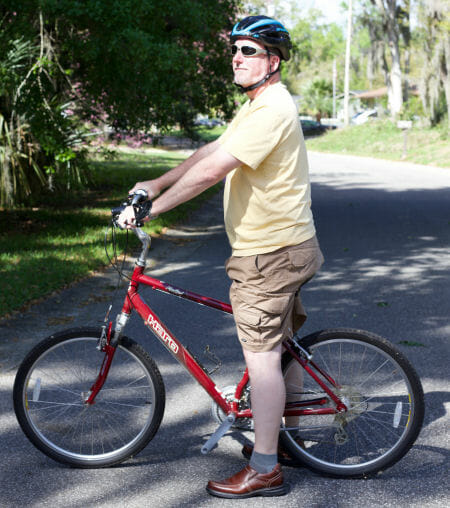Teaching Adults How to Ride a Bicycle
After I wrote the Savvy Cyclist post about teaching children, I began on this post. I realized there’s only one difference in teaching adults.
The difference is age. Although that is an obvious difference, there is more to it than just the number of years.
What isn’t different about teaching adults?
First, the steps I use for teaching adults are the same I use with kids. We lower the saddle and remove the pedals so that balancing and steering are easier to accomplish. I created a chart listing skills from being able to sit on a bicycle saddle to riding independently. We check off each skill as it is mastered, celebrate the progress, and then prepare for what’s next.
Even a student who first begins to advance the bike forward using the feet on the ground is working on several skills at once: Balance, steering, and processing touch/pressure from sitting on the saddle. We don’t stick to the order of skill mastery, as some students advance past a skill or two without directly working on them.
Second, adults — just like kids — are nervous learning a new activity that challenges their body and perseverance. It is important for me to present myself as a calm and patient teacher, without judgment. Students of all ages learn to ride easier and faster when they are relaxed and don’t feel pressure to perform at a particular level within a specific time.
Finally, adults experience the same excitement when they master riding a bike. From a teacher’s perspective, it’s a beautiful experience to witness a student’s feelings of success when this hard work comes to fruition.
The only difference
Age. That’s obvious, I know. However, I’m not referring to the number of years.
It’s what comes with age that can be problematic: Feelings of shame and embarrassment that build as one grows older not knowing how to ride a bicycle. A 48-year-old student shared that her new partner organized a bicycling excursion. Instead of divulging that she didn’t know how to ride, she frantically searched for someone to teach her.
Circumstances prohibit many people from learning during their childhood. A 28-year-old student mentioned that his parents forbade him from learning because his cousin was hit and killed while riding.
And a 45-year-old student spoke about growing up in a rough neighborhood. Staying safe inside her home was more of a priority than learning how to ride.
Thankfully, negative emotions disappear as bicycling is mastered. Feelings of joy and achievement replace feelings of shame and embarrassment. Circumstances that kept a student from learning become a distant memory.
Never too old to learn
So when a friend admits to not knowing how to ride a bicycle, don’t show shock or surprise. Be quick to remember the true age difference: Not the number of birthdays, but the feelings and history that come with age.
It may have taken your friend a lot of courage to tell you this. Casually mention that there are instructors who teach adults (see list at bottom of page). Inspire your friend to give it a try.
Teaching during the pandemic
Is it safe to teach anyone how to ride right now, in a pandemic? Yes!
In an email from June 6, 2020, John Ciccarelli, principal of Bicycle Solutions in San Francisco, described the additional precautions he’s using while teaching:

Pre-pandemic, John Ciccarelli assists a student raising the pedal for a power-pedal start.
“I and one of my five Bicycle Solutions instructor partners (League Cycling instructors) re-started lessons recently. His county (Santa Clara) already allows outdoor classes; San Francisco will allow them on June 15.
“I do bring my own bike for demos and coaching-while-riding, plus any teaching bikes I need for the client(s).
“I bring a cloth, soaked (sopping wet) in 70 percent isopropyl alcohol, in a one-gallon Ziploc bag, and use it for wiping bike contact surfaces, tools etc. In the few adult learn-to-ride lessons I’ve done in the past two weeks (one client, two lessons), I haven’t had to remove and re-install pedals, but if I did I’d just wipe those.
“We practice distancing. The client is never within six feet of me and if s/he needs me to adjust the bike s/he parks it and walks away from it. I do what’s needed, then I walk away.
“I wear a synthetic, loose ‘bandanna’-style face covering (Buff) and require my client to also wear one when near me, but not while riding. I talk only through the Buff. We ride along at a good separation distance and I coach on the fly, talking or shouting as needed. I only shout when they’re a considerable distance away.
“(I also have 3M N95 masks, but they’re too restrictive to talk through effectively during lessons. I wear one under the Buff when inside stores.)”
Update: We have another post about teaching techniques and a student’s progression.



